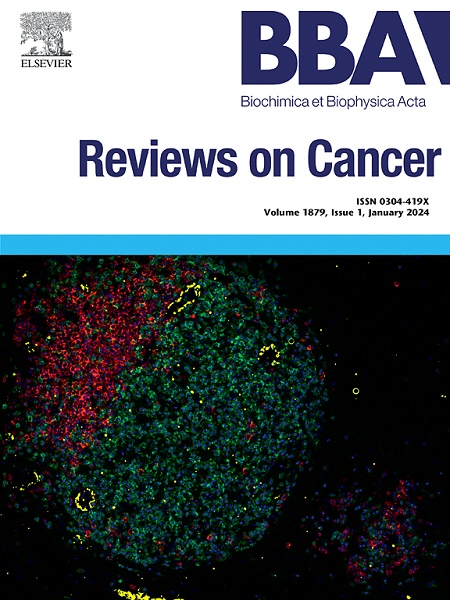CCL20-CCR6 signaling in tumor microenvironment: Functional roles, mechanisms, and immunotherapy targeting
IF 9.7
1区 医学
Q1 BIOCHEMISTRY & MOLECULAR BIOLOGY
Biochimica et biophysica acta. Reviews on cancer
Pub Date : 2025-05-08
DOI:10.1016/j.bbcan.2025.189341
引用次数: 0
Abstract
Chemokine C![]() C motif ligand 20 (CCL20) is a molecule with immunomodulatory properties that is involved in the regulation of diseases such as chronic inflammation, autoimmune diseases, and cancer. It operates by binding to its specific receptor, C
C motif ligand 20 (CCL20) is a molecule with immunomodulatory properties that is involved in the regulation of diseases such as chronic inflammation, autoimmune diseases, and cancer. It operates by binding to its specific receptor, C![]() C chemokine receptor type 6 (CCR6), and activating a complex intracellular signaling network. Building on its established role in inflammatory diseases, recent research has expanded our understanding of CCL20 to encompass its critical contributions to the tumor microenvironment (TME), highlighting its significance in cancer progression. Numerous studies have emphasized its prominent role in regulating immune responses. Consequently, Monoclonal antibodies against CCL20 and inhibitors of CCR6 have been successfully developed to block downstream signaling, making the CCL20-CCR6 axis a promising and critical target in the TME. This offers potential immunotherapeutic strategies for cancers. In this review, we summarize the biological consequences of CCL20-CCR6 mediated signaling, its role and mechanisms in the TME, and its potential applications. We suggest that the CCL20-CCR6 axis may be a novel biomarker for tumor diagnosis and prognosis, as well as a therapeutic target in various cancers.
C chemokine receptor type 6 (CCR6), and activating a complex intracellular signaling network. Building on its established role in inflammatory diseases, recent research has expanded our understanding of CCL20 to encompass its critical contributions to the tumor microenvironment (TME), highlighting its significance in cancer progression. Numerous studies have emphasized its prominent role in regulating immune responses. Consequently, Monoclonal antibodies against CCL20 and inhibitors of CCR6 have been successfully developed to block downstream signaling, making the CCL20-CCR6 axis a promising and critical target in the TME. This offers potential immunotherapeutic strategies for cancers. In this review, we summarize the biological consequences of CCL20-CCR6 mediated signaling, its role and mechanisms in the TME, and its potential applications. We suggest that the CCL20-CCR6 axis may be a novel biomarker for tumor diagnosis and prognosis, as well as a therapeutic target in various cancers.
肿瘤微环境中的CCL20-CCR6信号:功能作用、机制和免疫治疗靶向
趋化因子CC基序配体20 (CCL20)是一种具有免疫调节特性的分子,参与慢性炎症、自身免疫性疾病和癌症等疾病的调节。它通过结合其特异性受体CC趋化因子受体6型(CCR6)并激活复杂的细胞内信号网络而起作用。基于其在炎症性疾病中的既定作用,最近的研究扩大了我们对CCL20的理解,包括其对肿瘤微环境(TME)的关键贡献,强调了其在癌症进展中的重要性。大量研究强调其在调节免疫应答中的突出作用。因此,针对CCL20的单克隆抗体和CCR6的抑制剂已经成功地开发出来,可以阻断下游信号传导,使CCL20-CCR6轴成为TME中有希望和关键的靶点。这为癌症提供了潜在的免疫治疗策略。本文就CCL20-CCR6介导的信号转导的生物学后果、在TME中的作用和机制及其潜在应用进行综述。我们认为CCL20-CCR6轴可能是一种新的肿瘤诊断和预后的生物标志物,也是多种癌症的治疗靶点。
本文章由计算机程序翻译,如有差异,请以英文原文为准。
求助全文
约1分钟内获得全文
求助全文
来源期刊

Biochimica et biophysica acta. Reviews on cancer
医学-生化与分子生物学
CiteScore
17.20
自引率
0.00%
发文量
138
审稿时长
33 days
期刊介绍:
Biochimica et Biophysica Acta (BBA) - Reviews on Cancer encompasses the entirety of cancer biology and biochemistry, emphasizing oncogenes and tumor suppressor genes, growth-related cell cycle control signaling, carcinogenesis mechanisms, cell transformation, immunologic control mechanisms, genetics of human (mammalian) cancer, control of cell proliferation, genetic and molecular control of organismic development, rational anti-tumor drug design. It publishes mini-reviews and full reviews.
 求助内容:
求助内容: 应助结果提醒方式:
应助结果提醒方式:


